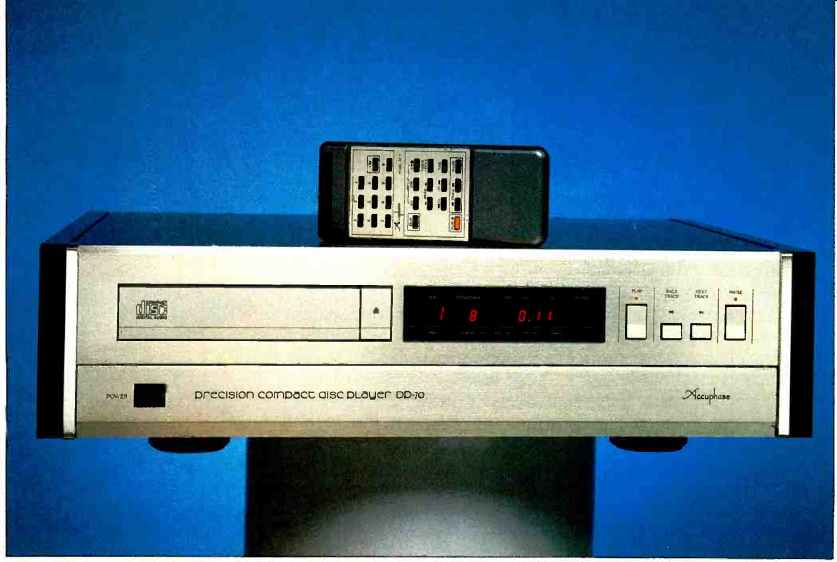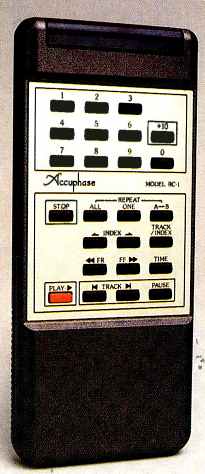

Company Address: Accuphase c/o Madrigal Ltd., P.O. Box 781, Middletown, Conn. 06457.
Like writing a column on fine wines, reviewing high-end equipment has its special pleasures, such as being able to audition a $5,000 CD player like the Accuphase DP-70. The only drawback is that, unlike wine reviewers, those of us who write about audio equipment have to give our samples back.
The Accuphase DP-70 is one of those audio components you'd probably want to try out even if you knew nothing about the price and technology. The styling is excellent, and if you like gadgets at all, you will be instantly impressed by the look of the player.
You will also be impressed by the feel.
The key controls are visible and conveniently located on the front of the unit (and on the supplied remote), while all the programming controls are hidden behind a swing-down panel. The back panel is not a simple black surface with two RCA jacks. It has both optical and conventional digital output jacks; balanced outputs; fixed, unbalanced RCA outputs, and a variable RCA out put. Even the weight of this unit is impressive. The moving mechanism is mounted on a ceramic composite, and the unit weighs 46.2 pounds. The drawer is actually metal, not the near-ubiquitous plastic which looks like it belongs in a toy store.
The DP-70's attributes are more than skin deep. Its drive system has exceptional stability and very sophisticated damping. A 16-bit design with four-times oversampling, the DP-70 is one of the few CD players-if not the only one-to employ a precision discrete D/A converter. It also uses four optical converters for each channel to isolate digital noise and r.f. from the audio section.
The analog stages have received as much attention as the digital stages.
Advanced Butterworth filters limit the audio signal to the audible range, and special circuitry reduces switching noise. The de-emphasis circuit is passive, and a buffer amplifier maintains sound quality. One master clock is used to avoid any "beat" that could interfere with sound quality. There is a separate power transformer for the analog stages, and each channel has a separate power supply. In concert with the latest thinking in high-end audio design, this player has a balanced XLR-type output.
What really makes the Accuphase DP-70 impressive, however, is its sound quality. Many expensive CD players have a host of technical features but fail to sound significantly better than their less costly competition.
The DP-70 sounds like it should cost $5,000.
Its most important advance is in the upper midrange and treble. The CD medium, for all its advantages in terms of linear frequency response and lack of measurable distortion, still tends to produce a flat upper-octave sound that lacks sweetness and harmonic detail.
At its worst, it is hard and unpleasant; even at its best, it lacks much of the natural air and sweetness of many analog tape and record units that theoretically should sound much worse.
These problems emerge in direct proportion to the overall transparency of the rest of the electronics used with the CD player, and also in proportion to how flat and quick the associated speaker is in handling upper-octave data. With many mid-fi cone speakers and low- to medium-quality electronics, the effect is masked by other distortions and by the significant treble roll-off common in such speakers. The Accuphase DP-70 is one of the few CD players that is fully compatible with the sonics of even the best electronics and speakers. More important, its achievement indicates that CD can audibly as well as technically outperform analog records and tape in the area where CD had formerly been the weakest. These improvements in the treble and upper midrange also improve the rest of the midrange, where the DP-70 has remarkable neutrality.
The DP-70 also has an exceptionally wide sound stage with a great deal of natural depth. Once again, this has been an area where even the best CD players generally did not do as well as their analog counterparts. This has led to speculation that the depth in analog records is some kind of euphonic coloration. The DP-70 strongly indicates that it isn't. If one compares the sound of the CD and LP record versions of "How High the Moon" on Jazz at the Pawnshop (Proprius 7778/9), the DP-70 shows that CD can equal or surpass even the best vinyl disc. In fact, the depth and sound stage provided by this player make other top-quality, high-end units sound a bit flat and two dimensional by comparison.
The DP-70 not only has excellent depth; it also has exceptional imaging capability, placing instruments from left to right without any hole in the middle or lack of width. This shows up very clearly in the reproduction of percussion instruments, which many CD players and cartridges make sound wider than they should. It also shows up in complex choral music, where good re production is essential to understanding the interplay among different voices and sections of a choir.
The DP-70 performs well in all other respects, but there are two areas where my listening to other CD players-including the more complex $8,000 Accuphase DP-80/DC-81 does indicate that the sound can be further improved. The most obvious area is the middle and deep bass. The DP-70 is one of a handful of CD players that have real force and power in the deep bass. It does not, however, have quite the warmth in the mid-bass that it should. Further, a few competing units can discriminate the details of bass instruments better. This is likely to be apparent only with those few speakers that can deliver real power below 40 Hz, but it will be important to true bass fanatics.
The second area is dynamics. The DP-70 is slightly restricted in its ability to reproduce dynamic transients. I had the opportunity to compare it to several new DAT recorders, other top CD players, and a top-ranking turntable/arm with a number of cartridges, using some new digital recordings on the GRP label. Once again, the DP-70 did very well. It outperformed or equaled all of the DAT recorders. Several top cartridges and at least one CD player, however, had a significantly more realistic sound when confronted by sudden changes in loudness or the sound of a cymbal. The DP-70 was just slightly lacking in apparent speed and impact.
To justify its existence, a $5,000 CD player must be able to define the state of the art and explore the practical limits of how good a Compact Disc can sound. If it fails to do so, the best technology in the world is useless. The DP-70 meets these standards in sever al important respects. It provides the best upper midrange and treble, the best combination of natural musical sweetness and air, and the best depth of any CD player I have heard to date.
However, while it is an outstanding player in every other respect as well, there are areas where other CD players do better. The bass is deep, powerful, and extended, but a few of the DP-70's rivals provide this performance with more detail and a better ability to reproduce the bass viol and cello. Some other players reproduce the rapid dynamic changes in music more realistically and reproduce the lower midrange and upper bass more accurately.
No piece of high-end equipment I have ever heard, however, has done everything better than its rivals. The Accuphase has its greatest strengths in the area where improved performance is most important to enjoying music, particularly classical music, female voice, acoustic rock, and naturally recorded jazz. It is particularly impressive in its ability to handle massed strings, woodwinds, and complex choral music. More broadly, it is the kind of unit that is worth auditioning just to see what CD can do. Once you hear it, you won't find it easy to settle for less.
-Anthony H. Cordesman
[AUDIO/Dec. 1987]
[adapted from Audio magazine]